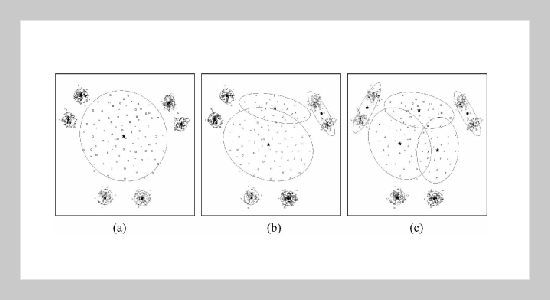REFERENCES
- [1] Moon, Todd K., “The Expectation-Maximization Algorithm,” IEEE Signal Processing Magazine, pp. 47� 60 (1996).
- [2] Dempster, A. P., Laird, N. M. and Rubin, D. B., “Maximum Likelihood from Incomplete Data via the EM Algorithm,” Journal of the Royal Statistical Society Series B, Vol. 39, pp. 1�38 (1977).
- [3] Bilmes, Jeff A. “A Gentle Tutorial of the EM Algorithm and its Application to Parameter Estimation for Gaussian Mixture and Hidden Markov Models,” Technical Report TR-97-021, Computer Science Division, Department of Electrical Engineering and Computer Science, U. C. Berkeley (1998).
- [4] Ball, G. and Hall, D. “A Clustering Technique for Summarizing Multivariate Data,” Behavioral Science, Vol. 12, pp. 153�155 (1967).
- [5] Dunn, J. C., “A Fuzzy Relative of the ISODATA Process and its Use in Detecting Compact Well-separated Clusters,” Journal Cybernetics, Vol. 3, pp. 95�104 (1974).
- [6] Frank Hoppner, Frank Klawonn, Rudolf Kruse and Thomas Runkler, Fuzzy Cluster Analysis, Methods for Classification, Data Analysis and Image Recognition, Wiley, New York, U.S.A. (2000).
- [7] Bezdek, James C., Pattern Recognition with Fuzzy Objective Function Algorithm. Plenum, New York, U.S.A. (1981).
- [8] Gustafson, Donald E. and Kessel, William C., “Fuzzy Clustering with a Fuzzy Covariance Matrix,” In Proc. of the IEEE Conference on Decision and Control, pp. 761�766 (1979).
- [9] Isak Gath and Geva, Amir. B., “Unsupervised Optimal Fuzzy Clustering,” IEEE Trans. Pattern Analysis and Machine Intelligence, Vol. 11, pp. 773�781 (1989).
- [10] Jorma Rissanen, “Modeling by Shortest Data Description,” Automatica, Vol. 14, pp. 465�471 (1978).
- [11] Gideon Schwarz, “Estimating the Dimension of a Model,” The Annals of Statistics, Vol. 6, pp. 461�464 (1978).
- [12] Chris Fraley and Raftery, Adrian E., “How Many Clusters? Which Clustering Method? Answers via Modelbased Cluster Analysis,” The Computer Journal, Vol. 41, pp. 578�588 (1998).
- [13] Peter Cheeseman and John Stutz, Bayesian Classification (AutoClass): Theory and Results, In U. Fayyad, G. Piatetsky-Shapiro, P. Smyth and U. Uthurusamy, Advances in Knowledge Discovery and Data Mining, AAAI Press/MIT Press. 153�180 (1996).
- [14] Pal, Nikhil R. and Bezdek, James C., “On Cluster Vaidity for the Fuzzy c-means Model,” IEEE Trans. Fuzzy Systems, Vol. 3, pp. 370�379 (1995).
- [15] Lawrence O. Hall, Ibrahim Burak Ozyurt, and Bezdek, James C., “Clustering with a Genetically Optimized Approach,” IEEE Transactions on Evolutionary Computation, Vol. 3, pp. 103�112 (1999).
- [16] Nir Friedman, Matan Ninio, Itsik Pe’er, and Tal Pupko, “A Structural EM Algorithm for Phylogenetic Inference,” Journal of Computational Biology. Vol. 9, pp. 331�353 (2002).
- [17] Schachter, B., Davis, L. and Rosenfeld, A., “Some Experiments in Image Segmentation by Clustering of Local Feature Values,” Pattern Recognition, Vol. 11, pp. 19�28 (1979).
- [18] Naonori Ueda, Ryohei Nakano, Zoubin Ghahramani and Hinton, Geoffrey E. “SMEM Algorithm for Mixture Models,” Neural Computation, Vol. 12, pp. 2109� 2128 (2000).
- [19] Nikos Vlassis and Aristidis Likas, “A Greedy EM Algorithm for Gaussian Mixture Learning,” Neural Processing Letters, Vol. 15, pp. 77�87 (2002).
- [20] Henry. C. Thode, Jr., Stephen J. Finch and Nancy R. Mendell, “Simulated Percentage Points for the Null Distribution of the Likelihood Ratio Test for a Mixture of Two Normals,” Biometrics, Vol. 44, pp. 1195�1201 (1988).
- [21] Richard A. Johnson and Dean W. Wichern, Applied Multivariate Statistical Analysis, Third Edition, Prentice-Hall (1992).
- [22] Sergios Theodoridis and Konstantinos Koutroumbas, Pattern Recognition, Academic Press (1999).
- [23] Gentle, James E. Random Number Generation and Monte Carlo Methods, Springer (1998).
- [24] William H. Press, Brian P. Flannery, Saul A. Teukolsk and William T., Vetterling, Numerical recipes in C, Cambridge University Press (1988).
- [25] Yoav Freund and Yishay Mansour, “Estimating a Mixture of Two Product Distributions,” ACM Conference on Computational Learning Theory, pp. 53�59 (1999).
- [26] Blake, C. L. and Merz, C. J., “UCI Repository of Machine Learning Databases,” University of California, Irvine, Department of Information and Computer Sciences (1998).
- [27] Aeberhard, S., Coomans, D. and de Vel, O., “Comparison of Classifiers in High Dimensional Settings,” Technical Report No. 92�02, (1992), Department of Computer Science and Department of Mathematics and Statistics, James Cook University of North Queensland (1992).
- [28] Aeberhard, S., Coomans, D. and de Vel, O., “The Classification Performance of RDA,” Technical Report No. 92�01, (1992), Department of Computer Science and Department of Mathematics and Statistics, James Cook University of North Queensland (1992).
- [29] Soumen Chakrabarti, Mining the Web, Discovering Knowledge from Hypertext Data, Morgan Kaufmann Publishers (2003).
- [30] Zhihua Zhang, Chibiao Chen, Jian Sun and Kap Luk Chan, “EM Algorithms for Learning Gaussian Mixture Models with Split-and-Merge Operation,” Pattern Recognition, Vol. 36, pp. 1973�1983 (2003).
- [31] Tao, C. W. “Unsupervised Fuzzy Clustering with Multi-center Clusters,” Fuzzy Sets and Systems, Vol. 128, pp. 305�322 (2002).
- [32] Asa Ben-Hur, David Horn, Hava T. Siegelmann and Vladimir Vapnik. “Support Vector Clustering,” Journal of Machine Learning Research, Vol. 2, pp. 125� 137 (2002).
















